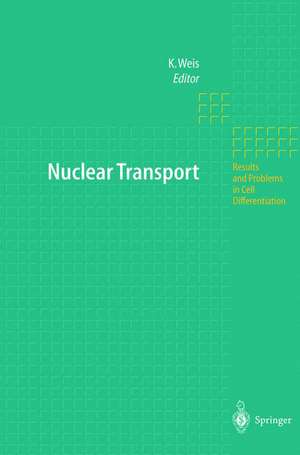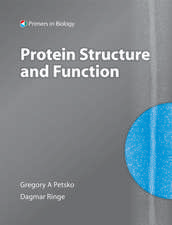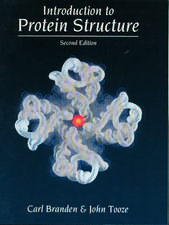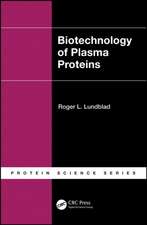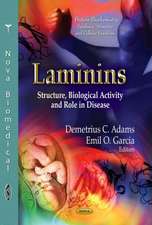Nuclear Transport: Results and Problems in Cell Differentiation, cartea 35
Editat de Karsten Weisen Limba Engleză Hardback – 20 noi 2001
This volume summarizes our current knowledge of protein and RNA transport into and out of the nucleus. It contains nine up-to-date reviews which cover various aspects of nucleocytoplasmic transport, including the structure and function of the nuclear pore complex, the role of soluble transport factors in protein and RNA transport, and the regulation of protein transport through the nuclear pore.
| Toate formatele și edițiile | Preț | Express |
|---|---|---|
| Paperback (1) | 636.30 lei 6-8 săpt. | |
| Springer Berlin, Heidelberg – 24 iul 2012 | 636.30 lei 6-8 săpt. | |
| Hardback (1) | 642.51 lei 6-8 săpt. | |
| Springer Berlin, Heidelberg – 20 noi 2001 | 642.51 lei 6-8 săpt. |
Din seria Results and Problems in Cell Differentiation
- 18%
 Preț: 1391.73 lei
Preț: 1391.73 lei - 15%
 Preț: 597.16 lei
Preț: 597.16 lei -
 Preț: 387.96 lei
Preț: 387.96 lei - 5%
 Preț: 373.33 lei
Preț: 373.33 lei -
 Preț: 382.18 lei
Preț: 382.18 lei -
 Preț: 385.08 lei
Preț: 385.08 lei - 15%
 Preț: 644.82 lei
Preț: 644.82 lei - 15%
 Preț: 634.00 lei
Preț: 634.00 lei -
 Preț: 387.20 lei
Preț: 387.20 lei -
 Preț: 387.75 lei
Preț: 387.75 lei - 15%
 Preț: 643.34 lei
Preț: 643.34 lei -
 Preț: 382.18 lei
Preț: 382.18 lei -
 Preț: 394.71 lei
Preț: 394.71 lei -
 Preț: 390.08 lei
Preț: 390.08 lei -
 Preț: 381.43 lei
Preț: 381.43 lei -
 Preț: 385.47 lei
Preț: 385.47 lei -
 Preț: 385.47 lei
Preț: 385.47 lei -
 Preț: 391.22 lei
Preț: 391.22 lei - 18%
 Preț: 1227.04 lei
Preț: 1227.04 lei - 20%
 Preț: 561.68 lei
Preț: 561.68 lei - 5%
 Preț: 1418.27 lei
Preț: 1418.27 lei -
 Preț: 386.00 lei
Preț: 386.00 lei -
 Preț: 377.95 lei
Preț: 377.95 lei -
 Preț: 391.61 lei
Preț: 391.61 lei -
 Preț: 388.52 lei
Preț: 388.52 lei - 18%
 Preț: 1380.63 lei
Preț: 1380.63 lei - 15%
 Preț: 639.25 lei
Preț: 639.25 lei - 18%
 Preț: 1220.12 lei
Preț: 1220.12 lei - 15%
 Preț: 640.37 lei
Preț: 640.37 lei - 18%
 Preț: 1222.49 lei
Preț: 1222.49 lei - 18%
 Preț: 946.41 lei
Preț: 946.41 lei -
 Preț: 387.38 lei
Preț: 387.38 lei - 18%
 Preț: 1228.47 lei
Preț: 1228.47 lei - 15%
 Preț: 642.51 lei
Preț: 642.51 lei - 18%
 Preț: 1663.00 lei
Preț: 1663.00 lei - 18%
 Preț: 1225.62 lei
Preț: 1225.62 lei
Preț: 642.51 lei
Preț vechi: 755.88 lei
-15% Nou
Puncte Express: 964
Preț estimativ în valută:
122.94€ • 128.37$ • 101.52£
122.94€ • 128.37$ • 101.52£
Carte tipărită la comandă
Livrare economică 15-29 aprilie
Preluare comenzi: 021 569.72.76
Specificații
ISBN-13: 9783540423683
ISBN-10: 3540423680
Pagini: 212
Ilustrații: XIII, 197 p. 78 illus.
Dimensiuni: 155 x 235 x 14 mm
Greutate: 0.48 kg
Ediția:2002
Editura: Springer Berlin, Heidelberg
Colecția Springer
Seria Results and Problems in Cell Differentiation
Locul publicării:Berlin, Heidelberg, Germany
ISBN-10: 3540423680
Pagini: 212
Ilustrații: XIII, 197 p. 78 illus.
Dimensiuni: 155 x 235 x 14 mm
Greutate: 0.48 kg
Ediția:2002
Editura: Springer Berlin, Heidelberg
Colecția Springer
Seria Results and Problems in Cell Differentiation
Locul publicării:Berlin, Heidelberg, Germany
Public țintă
ResearchCuprins
The Structure and Composition of the Yeast NPC.- 1 Introduction.- 2 Overview of the Yeast NPC Structure.- 3 Yeast Nucleoporins: What’s NUP, What’s Not.- 4 The Yeast NPC as a Dynamic Structure.- 5 Putting It All Together: The Internal Organization of the Yeast NPC.- 6 Functional Environment of the Yeast NPC: The Interactions with Its Neighbors.- 7 Mechanism of Nucleocytoplasmic Transport.- References.- The Vertebrate Nuclear Pore Complex: From Structure to Function.- 1 Introduction.- 2 Toward the Three-Dimensional Architecture of the Nuclear Pore Complex.- 3 Molecular Constituents of the Nuclear Pore Complex: The Nucleoporins.- 4 What Is the Functional Significance of the Multiple Locations of Nucleoporins?.- 5 From Nuclear Pore Complex Structure to Nucleocytoplasmic Transport.- 6 Concluding Remarks.- References.- How Ran Is Regulated.- 1 Ran Belongs to the Superfamily of Ras-Related Proteins.- 2 Ran.- 3 Stimulation of Guanine Nucleotide Exchange by RanGEF.- 4 Induction of the Ran GTPase by RanGAP.- 5 Role of Ran in Protein Import.- 6 Effects of Importin-?-Related Proteins on the Activities of Ran.- 7 Recycling of Exported Import Factors by RanBP1/RanBP2.- 8 Export of Macromolecules from the Nucleus.- 9 Role of RanBP3 in Exportin-l-Mediated Export.- 10 Import of Ran into the Nucleus.- 11 Mogl Induces Release of GTP from Ran.- 12 RanGTP in Mitosis.- References.- Exportin-Mediated Nuclear Export of Proteins and Ribonucleoproteins.- 1 Introduction.- 2 Ran Is King.- 3 Exportins.- 4 CRM1/Exportin-1.- 5 Exportin-Mediated Export of Ribonucleoproteins.- 6 Exportin-4.- 7 Msn5/Exportin-5.- 8 Interaction of Exportins with the Nuclear Pore Complex.- 9 Perspectives.- References.- Structures of Importins.- 1 Introduction.- 2 NLS Recognition: Association with a.- 3 Cargo Bindingto the Receptor: Importin-?-Binding Association with ?.- 4 Cargo Release: RanGTP Binding to ? and ?2.- 5 Nuclear Pore Complex Docking.- 6 From Static Snapshots to a Dynamic Picture.- Addendum.- References.- Nuclear Export of tRNA.- 1 Introduction.- 2 tRNA Processing: Preparation to Exit the Nucleus?.- 3 A Distinct Pathway for the Nuclear Export of Mature tRNA.- 4 Identification of Los 1p/Xpo-t as a Nuclear Export Receptor for tRNA.- 5 Structural Requirements for the Xpo-t/tRNA Interaction: A Proofreading Mechanism?.- 6 An Alternative Nuclear tRNA Export Pathway and the Role of Aminoacylation.- 7 Nuclear tRNA Export as a Regulatory Mechanism?.- 8 Concluding Remarks.- References.- Nuclear Export of Messenger RNA.- 1 Introduction.- 2 RAE1/Gle2p and TAP/Mex67p May Function as Nuclear Export Receptors for mRNA.- 3 Role of hnRNP-Like Proteins in mRNA Export.- 4 Export of Spliced and Unspliced mRNAs.- 5 Disassembly of Export Complexes and Recycling of Export Factors: The Role of Dbp5.- 6 Perspectives.- References.- Using Retroviruses To Study the Nuclear Export of mRNA.- 1 Nuclear mRNA Export and the Retroviral Life Cycle.- 2 Crml-Dependent Retroviral mRNA Export.- 3 Tap-Dependent Retroviral mRNA Export.- 4 Other Retroviruses, Other Pathways?.- References.- Regulated Nuclear Transport.- 1 Introduction.- 2 Protein Kinases.- 3 Transcription Factors.- 4 Stress Regulation of Nuclear mRNA Export.- 5 Some General Conclusions.- References.
Textul de pe ultima copertă
Bidirectional traffic of macromolecules across the nuclear envelope is an active and essential transport process in all eukaryotic cells. Work on various model systems has led to a tremendous increase in our understanding of nuclear transport in recent years.
This volume summarizes our current knowledge of protein and RNA transport into and out of the nucleus. It contains nine up-to-date reviews which cover various aspects of nucleocytoplasmic transport, including the structure and function of the nuclear pore complex, the role of soluble transport factors in protein and RNA transport, and the regulation of protein transport through the nuclear pore.
This volume summarizes our current knowledge of protein and RNA transport into and out of the nucleus. It contains nine up-to-date reviews which cover various aspects of nucleocytoplasmic transport, including the structure and function of the nuclear pore complex, the role of soluble transport factors in protein and RNA transport, and the regulation of protein transport through the nuclear pore.
Caracteristici
Up-to-date and comprehensive overview of nucleocytoplasmic transport. Includes supplementary material: sn.pub/extras
